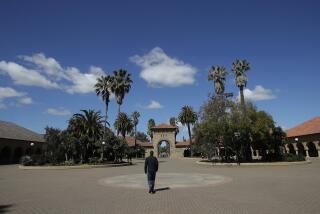Higher Education Needs to Keep Taking Chances
Of all the changes that have transformed American society in the last quarter century, none is more important than the expansion of public higher education. And no state in the nation has supported higher education as generously--or reaped as many benefits from it--as California.
The California system was born with the 1960 Master Plan, largely the product of former UC President Clark Kerrâs inventive mind. Its genius was its simplicity: three levels of institutions guaranteed admission to all high school graduates. The best students went to the University of California system, those in the middle attended the state colleges and the least academically able headed off to the community colleges.
It was a bold and successful experiment, one that helped reshape American higher education.
Now there is trouble in paradise. There are serious problems at all levels that require careful attention and tough choices. The community colleges face an identity crisis, the product of the imposition of tuition and uncertainty about their mission. They must also deal with the fact that few of their graduates advance to four-year colleges or universities.
The state colleges have their own problems. Some are undistinguished schools. Attrition is high; only a small percentage of students graduate on time. Educational standards need to be raised (and some efforts have been made to do so), but this will probably reduce minority enrollment.
Even the UC system has difficulties--the institutions are often more concerned with research than teaching. As a result, they place more emphasis on graduate students than undergraduates.
But no issue illustrates as clearly the complex choices facing California higher education than the proposal to let the state colleges grant doctoral degrees in educational administration.
W. Ann Reynolds, chancellor of the California State University system, maintains that the doctorate has replaced the masterâs degree as the professional degree that school administrators need to get ahead. California awards relatively few education doctorates and CSU educates most of the stateâs teachers. Those who get doctoral degrees in education in the UC system, she says, are more interested in research than in becoming school administrators.
This stand has attracted a lot of critics. Those in the UC system say that existing programs should be expanded before new ones are created. Some critics suggest that the new programs will offer little more than âcounterfeitâ credentials.
There is merit to both sides of the argument. California needs more elementary and secondary school educators. But it is not really clear that new doctoral programs are needed anywhere. These programs cost a lot of money to operate. And there is always the danger that educational quality will be sacrificed to institutional ambition. Yet itâs hard to criticize institutions that have ambitious visions. Most of us would hope to attend, or want our children to attend, schools that are trying to improve their status. The last thing California (or any other state) needs is more second-rate universities.
There are no simple solutions. The truth is that it was easier to create a higher education system in the 1960s when our hopes were high and resources were plentiful than it is to maintain a system in the 1980s when we are acutely aware of the limits of public policy.
Resolving the dispute over new doctoral programs will not be easy. One solution would be to try the idea on an experimental basis. Provisional programs should be approved at one or two CSU campuses. After several years, the state can decide whether to grant permanent approval.
The key to the experiment will be a hard-nosed evaluation and abiding by the results. The evaluation, now being conducted by a statewide commission charged with studying the future of Californiaâs system of higher education, should have two overriding concerns. The most important is academic quality. The programs must be rigorous, with high standards for students and faculty alike. The other is need. The programs must meet a public need that cannot be met otherwise. In other words, the CSU system should provide what the UC system does not. The burden of proof must be on the new programs. If they fail to meet either concern, they should be abandoned permanently.
These criteria may prove insurmountable. The state colleges are not now known for their exceptional academic quality and the UC system could easily meet the stateâs needs for school administrators if it choses to do so. But competition produces more effective and efficient services.
In a period of scarce resources, it is usually easier to maintain the status quo than it is to try a new idea. But taking chances helped build the worldâs most impressive system of higher education. California shouldnât stop experimenting now.
More to Read
Sign up for Essential California
The most important California stories and recommendations in your inbox every morning.
You may occasionally receive promotional content from the Los Angeles Times.










